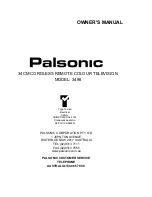
Circuit Descriptions, Abbreviation List, and IC Data Sheets
9.
(FBX6= based on PICNIC, FBX7=
based on PICNIC and Eagle, FBX8=
based on PICNIC, Eagle, and
Columbus)
H
H_sync to the module
HD
High Definition
I
Monochrome TV system. Sound
carrier distance is 6.0 MHz. VHF- and
UHF-band
I
2
C
Integrated IC bus
I
2
S
Integrated IC Sound bus
IC
Integrated Circuit
IF
Intermediate Frequency
Interlaced
Scan mode where two fields are used
to form one frame. Each field contains
half the number of the total amount of
lines. The fields are written in "pairs",
causing line flicker.
IR
Infra Red
IRQ
Interrupt ReQuest
LATAM
LATin AMerica
LCD
Liquid Crystal Display
LED
Light Emitting Diode; A semiconductor
diode that emits light when a current is
passed through it
L/L'
Monochrome TV system. Sound
carrier distance is 6.5 MHz. L' is Band
I, L is all bands except for Band I
LVDS
Low Voltage Differential Signalling,
data transmission system for high
speed and low EMI communication.
MHEG
Multimedia and Hypermedia
information coding Expert Group
M/N
Monochrome TV system. Sound
carrier distance is 4.5 MHz. M= 525
lines @ 60 Hz, N= 625 lines @ 50 Hz
MOSFET
Metal Oxide Semiconductor Field
Effect Transistor
MPEG
Motion Pictures Experts Group. An
ISO/IEC body that has given its name
to an image compressing scheme for
moving video
MSP
Multi-standard Sound Processor: ITT
sound decoder
NC
Not Connected
NICAM
Near Instantaneously Companded
Audio Multiplexing; This is a digital
sound system, mainly used in Europe
NTSC
National Television Standard
Committee. Colour system used
mainly in North America and Japan.
Colour carrier NTSC M/N = 3.579545
MHz, NTSC 4.43 = 4.433619 MHz
(this is a VCR norm, it is not
transmitted off-air)
NVM
Non Volatile Memory; IC containing
data such as alignment values, preset
stations
O/C
Open Circuit
PAL
Phase Alternating Line. Colour system
used mainly in Western Europe
(colour carrier = 4.433619 MHz) and
South America (colour carrier PAL M =
3.575612 MHz and PAL N = 3.582056
MHz)
PCB
Printed Circuit Board (or PWB)
PCMCIA
Personal Computer Memory Card
International Association
PLL
Phase Locked Loop. Used, for
example, in FST tuning systems. The
customer can directly provide the
desired frequency
Progressive Scan
Scan mode where all scan lines are
displayed in one frame at the same
time, creating a double vertical
resolution.
PWB
Printed Wiring Board (also called PCB
or CBA)
QAM
Quadrature Amplitude Modulation;
modulation method
QPSK
Quadratture Phase Shift Keying (or 4-
QAM)
RAM
Random Access Memory
RC
Remote Control transmitter
RGB
Red, Green, and Blue colour space;
The primary colour signals for TV. By
mixing levels of R, G, and B, all colours
(Y/C) are reproduced
RGBHV
Red, Green, Blue, Horizontal sync,
and Vertical sync
ROM
Read Only Memory
SAM
Service Alignment Mode
SC-IN
SCART in
SC-OUT
SCART out
S/C
Short Circuit
SCART
Syndicat des Constructeurs
d'Appareils Radiorécepteurs et
Téléviseurs; This is a 21-pin connector
used in EU, that carries various audio,
video, and control signals (it is also
called Péritel connector)
SCL
Serial CLock Signal on I
2
C bus
SD
Standard Definition
SDRAM
Synchronous DRAM
SECAM
SÉquence Couleur Avec Mémoire;
Colour system mainly used in France
and East Europe. The chroma is FM
modulated and the R-Y and B-Y
signals are transmitted line
sequentially. Colour carriers=
4.406250 MHz and 4.250000 MHz
SIF
Sound Intermediate Frequency
S/PDIF
Sony Philips Digital InterFace; This is
a consumer interface used to transfer
digital audio
SRAM
Static RAM
STBY
STandBY
SVHS
Super Video Home System
SW
Software or Subwoofer or Switch
TXT
Teletext; TXT is a digital addition to
analogue TV signals that contain
textual and graphical information (25
rows x 40 columns). The information is
transmitted within the first 25 lines
during the Vertical Blank Interval (VBI)
uP
Microprocessor
VCR
Video Cassette Recorder
XTAL
Quartz crystal
Y
Luminance signal
Y/C
Y consists of luminance signal,
blanking level and sync; C consists of
chroma (colour) signal
YPbPr
This is a scaled version of the YUV
colour space. Y= Luminance, Pb/Pr=
Colour difference signals B-Y and R-Y,
other amplitudes w.r.t. to YUV
YUV
Colour space used by the NTSC and
PAL video systems. Y is the luminance
and U/V are the colour difference
signals







































